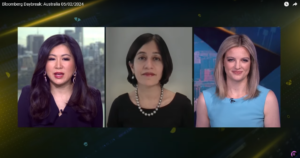YTD 2024
At the time of writing this note, Emerging Market equities have delivered 7.8% YTD 2024, with significant volatility, including trough to peak performance of over 15%. The drivers of returns have varied by region and much of the recent rebound has been driven by China. This note discusses the various drivers of returns in EM this year.

U.S. Inflation:
U.S. inflation impacts emerging markets in several ways. High inflation in the U.S. typically implies a high interest rate regime which favors the U.S. Dollar and suggests relative weakness for EM currencies. Higher U.S. interest rates raise the cost of capital and restrict money supply. In such a scenario, investors typically move to “risk-off sentiment.”
Within Emerging Markets, Latin American markets have historically been most sensitive to U.S. rates. This effect was somewhat dampened in 2022-2023, when LatAm was supported by higher commodity prices and idiosyncratic issues like the presidential election in Brazil. Nevertheless, Latin America felt the brunt of the U.S. Fed’s “higher-for-longer” regime in 2024. MSCI LatAm returned -7% in the first four months of the year, despite commodities rallying over 7% in the same time period. Korea has also felt the impact of higher rates with the currency devaluing over 5% YTD.
The NVIDIA Trade:
The demand for technology hardware and the AI fueled rally have had strong spillover effects in Asia, especially in Taiwan and selectively, in Korea. The FTSE TWSE Technology index, which has a 61% weight to TSMC, had returned over 22% in local terms, over Jan-April 2024. Below is a chart plotting the YTD returns of Nvidia and TSMC.

China:
China has rallied almost 37% from its low point in Oct 2022 and been a significant contributor to the overall index return. Nevertheless still 40% below its previous peak in Jan 2021. China’s performance is almost entirely driven by local challenges, including the anemic post covid recovery, the debt riddled property sector and the heavy-handed approach to dealing with successful Chinese corporates.

The start of the rebound is encouraging. Consumer sentiment is improving, GDP and manufacturing data have turned better and policy support for the property sector may finally be having an impact in stabilizing prices.
India:
Uncertainty looms large as the populous goes to vote in India. Foreigners have been shying away from Indian equities, replaced by domestic institutional and retail investors. Pension investors via “Systematic Investment Plans” (SIPs) have been buying Indian equities, especially Indian small cap stocks. Importantly, fundamentals appear strong, government policies are finally favorable towards the corporate sector and India is benefiting from the China Plus One winds. MSCI India has delivered 8% over Jan-Apr 2024.
Middle East and South Asia:
These markets have been close to flat so far this year, with reasonable dispersion within the countries. The conflict in the middle east has weighed on investor sentiment in the region while South Asia has had no clear growth driver. Even though market returns have been lackluster, the dispersion has provided a strong backdrop for successful stock selection.
Conclusion:
Emerging Market equities are still reasonably valued and have the potential to deliver upside. The path to higher returns is likely to have interim setbacks, i.e. volatility. Each country/region in EM is distinct and impacted differently by a range of global and domestic factors. Contact us to learn how we take advantage of the volatility in EM and the county specific nuances to generate strong total and active returns.






